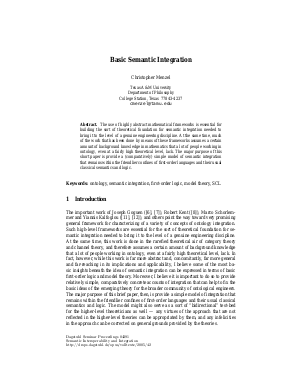Basic Semantic Integration
Author Chris Menzel
-
Part of:
Volume:
Dagstuhl Seminar Proceedings, Volume 4391
Part of: Series: Dagstuhl Seminar Proceedings (DagSemProc) - License:
 Creative Commons Attribution 4.0 International license
Creative Commons Attribution 4.0 International license
- Publication Date: 2005-03-23
File

PDF
DagSemProc.04391.4.pdf
- Filesize: 161 kB
- 13 pages
Document Identifiers
Subject Classification
Keywords
- ontology
- semantic integration
- first-order logic
- model theory
- SCL
Metrics
- Access Statistics
-
Total Accesses (updated on a weekly basis)
0PDF Downloads0Metadata Views
Abstract
The use of highly abstract mathematical frameworks is essential for building the sort of theoretical foundation for semantic integration needed to bring it to the level of a genuine engineering discipline. At the same time, much of the work that has been done by means of these frameworks assumes a certain amount of background knowledge in mathematics that a lot of people working in ontology, even at a fairly high theoretical level, lack. The major purpose of this short paper is provide a (comparatively) simple model of semantic integration that remains within the friendlier confines of first-order languages and their usual classical semantics and logic.
Cite As Get BibTex
Chris Menzel. Basic Semantic Integration. In Semantic Interoperability and Integration. Dagstuhl Seminar Proceedings, Volume 4391, pp. 1-13, Schloss Dagstuhl – Leibniz-Zentrum für Informatik (2005)
https://doi.org/10.4230/DagSemProc.04391.4
BibTex
@InProceedings{menzel:DagSemProc.04391.4,
author = {Menzel, Chris},
title = {{Basic Semantic Integration}},
booktitle = {Semantic Interoperability and Integration},
pages = {1--13},
series = {Dagstuhl Seminar Proceedings (DagSemProc)},
ISSN = {1862-4405},
year = {2005},
volume = {4391},
editor = {Y. Kalfoglou and M. Schorlemmer and A. Sheth and S. Staab and M. Uschold},
publisher = {Schloss Dagstuhl -- Leibniz-Zentrum f{\"u}r Informatik},
address = {Dagstuhl, Germany},
URL = {https://drops.dagstuhl.de/entities/document/10.4230/DagSemProc.04391.4},
URN = {urn:nbn:de:0030-drops-422},
doi = {10.4230/DagSemProc.04391.4},
annote = {Keywords: ontology , semantic integration , first-order logic , model theory , SCL}
}
